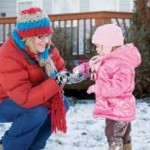Children Frostbite Symptoms and Treatment
 Frostbite is a medical condition in which the skin and skin tissues gets damaged due to exposure to extreme cold conditions. Frostbites generally occur on the parts of the body which are exposed to the outside weather conditions, remain uncovered for a long time and also are away from the heart.
Frostbite is a medical condition in which the skin and skin tissues gets damaged due to exposure to extreme cold conditions. Frostbites generally occur on the parts of the body which are exposed to the outside weather conditions, remain uncovered for a long time and also are away from the heart.
Signs and Symptoms
The initial stage of wind chill frostbite is termed as frost nip. It results from superficial cooling of tissues without destruction of cells. The surface of the skin gets affected and there is sensation of itching and pain and the skin develops red, white and yellow patches. Soon there is feeling of numbness. As there is no damage to lower layers of skin the condition soon becomes normal and often the upper layer of skin peels off.
The next stage, also called second degree of frost bite, results in development of chilblains, also called the ulcers of skin caused due to repeated exposure to cold. The skin freezes and becomes hard but the deeper layers remain unaffected. If not cared for properly ulcers may develop in a day or so. Healing takes about a month but the affected parts may lose sensation and the sensation of cold and hot may be lost.
Finally frost bite which results in destruction of tissues is termed as of it being of third and fourth degree. The muscles, tendons and blood vessels freeze. In some cases the portion of body exposed to frostbites may be lost permanently and damage caused to nerves may result in loss of sensation. In extreme cases fingers or toes may be amputated because of gangrene. If not treated the affected parts may also fall off.
Children who have tender skin are more likely to be affected easily and severely as compared to adults. Because of ignorance of consequences children may continue to play in extreme cold conditions despite exposure to cold and get affected. Mostly the exposed parts of the body will require immediate attention. Prolonged exposure may also result in the child developing hypothermia.
Treatment
The first stage called frost nip can be treated at home. When the child is indoors and complains of pain or numbness, ensure that all wet clothes are removed immediately. Wet clothes will absorb heat from the body. Make the child immerse the affected parts of the body like hands and feet in warm water. Keep a check on the child, do not let him reheat the water himself or go near the heater or fireplace as due to numbness of skin he may not make a correct estimate of temperature and get burnt. If sensation does not return in about an hour, consult the doctor.
In case of full frost bite an emergency visit to the doctor may be required. Pending availability of ambulance or other means of transportation dip the affected parts of the body in warm water or wrap the child in dry thick cloth so that body warmth is not lost, he can be given something hot to drink. Ensure that the skin that has thawed does not refreeze. This will result in permanent damage to the tissues. It is possible that blisters may develop on the affected parts. Keep them clean and dry and do not expose to dust etc as these may get infected and wounds may deteriorate.
In case you are living in the area which remains covered with snow for a long time and the temperature goes down considerably, ensure that the kids wear layers of clothes to cover the body. The parts of body which are more prone to frost bites should be covered properly using hat, gloves, and thick socks and insulated boots. Ensure that the kids are back indoors at regular intervals. When the children are finally back indoors after playing, ensure that they remain for quite some time in a heated room so that their body temperature returns to normal. Check that the clothes are not wet. Keep the address of the medical team handy.
If you plan to travel to an area where temperature is low and you are from an area where temperature remains quite high, special precautions will be needed. Keep emergency supplies with you. It will be better if one of the members of the group has undergone first aid training especially relating to exposure to cold conditions.